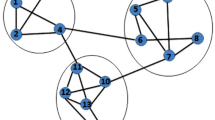Abstract
Community structure is one of the most important topological properties of complex networks, in which the intra-group links are very dense, but the inter-group links are quite sparse. Although there exists many works with regard to community mining, few of them studied the connections between the local distance among nodes and the global community structures of networks. In this work, we have studied their connection and established a corresponding heuristics depicting such a connection between local distance and community structure. On the basis of the heuristic, we have proposed a distance-based similarity measure as well as a novel community mining algorithm DSA. The DSA has been rigorously validated and tested against several benchmark networks. The experimental results show that the DSA is able to accurately discovery the potential communities with their hierarchical structures from real-world networks.
Access this chapter
Tax calculation will be finalised at checkout
Purchases are for personal use only
Preview
Unable to display preview. Download preview PDF.
Similar content being viewed by others
References
Watts, D.J., Strogatz, S.H.: Collective dynamics of Small-World networks. Nature 393(6638), 440–442 (1998)
Barabási, A.L., Albert, R.: Emergence of scaling in random networks. Science 286(5439), 509–512 (1999)
Girvan, M., Newman, M.E.J.: Community structure in social and biological networks. Proc. Natl. Acad. Sci. USA 9(12), 7821–7826 (2002)
Yang, B., Liu, D., Liu, J.: Discovering Communities from Social Networks: Methodologies and Applications. In: The Handbook of Social Networks: Technologies and Applications, Part 2, pp. 331–346. Springer, Heidelberg (2010)
Shi, J., Malik, J.: Normalized cuts and image segmentation. IEEE Trans. on Pattern Analysis and Machine Intelligent 22(8), 888–904 (2000)
Kernighan, B.W., Lin, S.: An efficient heuristic procedure for portioning graphs. Bell System Technical Journal 49, 291–307 (1970)
Newman, M.E.J.: Fast algorithm for detecting community structure in networks. Physical Review E 69(6), 066133 (2004)
Guimera, R., Amaral, L.A.N.: Functional cartography of complex metabolic networks. Nature 433(7028), 895–900 (2005)
Kleinberg, J.M.: Authoritative sources in a hyperlinked environment. Journal of the ACM 46(5), 604–632 (1999)
Radicchi, F., Castellano, C., Cecconi, F., Loreto, V., Parisi, D.: Defining and identifying communities in networks. Proc Natl Acad Sci USA 101(9), 2658–2663 (2004)
Wu, F., Huberman, B.A.: Finding communities in linear time: a physics approach. European Physical Journal B 38(2), 331–338 (2004)
Yang, B., Liu, J., Feng, J.: On the Spectral Characterization and Scalable Mining of Network Communities. IEEE Transactions on Knowledge and Data Engineering (2010) (preprint)
Newman, M.E.J.: Modularity and community structure in networks. Proc. Natl. Acad. Sci. USA 103(23), 8577–8582 (2006)
Zachary, W.W.: An information flow model for conflict and fission in small groups. Journal of Anthropological Research 33(4), 452–473 (1977)
Lusseau, D.: The emergent properties of a dolphin social network. Proceedings of the Royal Society of London-Series B 270(suppl. 2), S186–S188 (2003)
Nelson, D.L., McEvoy, C.L., Schreiber, T.A.: The University of South Florida word association, rhyme, and word fragment norms. Behavior Research Methods, Instruments, & Computers 36(3), 402–407 (2004)
Author information
Authors and Affiliations
Editor information
Editors and Affiliations
Rights and permissions
Copyright information
© 2011 Springer-Verlag Berlin Heidelberg
About this chapter
Cite this chapter
Li, Z., Yang, B. (2011). Mining Hierarchical Communities from Complex Networks Using Distance-Based Similarity. In: Ryżko, D., Rybiński, H., Gawrysiak, P., Kryszkiewicz, M. (eds) Emerging Intelligent Technologies in Industry. Studies in Computational Intelligence, vol 369. Springer, Berlin, Heidelberg. https://doi.org/10.1007/978-3-642-22732-5_16
Download citation
DOI: https://doi.org/10.1007/978-3-642-22732-5_16
Publisher Name: Springer, Berlin, Heidelberg
Print ISBN: 978-3-642-22731-8
Online ISBN: 978-3-642-22732-5
eBook Packages: EngineeringEngineering (R0)




